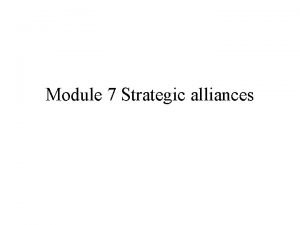STRATEGIC ALLIANCES JOINT VENTURE STRATEGIC ALLIANCES An arrangement



















- Slides: 19

STRATEGIC ALLIANCES & JOINT VENTURE

STRATEGIC ALLIANCES • An arrangement between two companies that have decided to share resources to undertake a specific, mutually beneficial project. • The mutual coordination of strategic planning and management that enable two or more organizations to align their long term goals to the benefit of each organization – generally, the organizations remain independent. • In a strategic alliance, each company maintains its autonomy while gaining a new opportunity. • A strategic alliance could help a company develop a more effective process, expand into a new market or develop an advantage over a competitor, among other possibilities

Ø Bottom line, strategic alliances are partnerships that stress mutual problem solving. Ø Each party in the alliance maintains autonomy. Ø Strategic alliances facilitate increasing a company’s scale, scope, and capabilities, while minimizing the risk involved in a merger/acquisition. Ø Increased numbers of strategic alliances and joint ventures are being driven by suppliers responding to corporate requirements tied to strategic sourcing, contracts getting larger and larger due to industry consolidations, and global competition.

EXAMPLES • In July 2011, Face book announced a strategic alliance with Skype, which had been recently acquired by Microsoft. This allowed Microsoft to quickly move into the social networking space, Skype received access to a large number of new users and Face book could leverage Skype's technology to enable video chat without making the investment in building it. • 01 st, Oct 2007 Kingfisher Airlines Inks Strategic Alliance with American Express. • Microsoft India announces strategic alliance with TCS • Tata Coffee & Starbucks Sign Mo. U for Strategic Alliance in India in January 13, 2011

Characteristics of a Strategic Alliance • May or may not be a contractual arrangement, but this is always recommended. • Long Term Relationship • High Level of Trust • Win/Win (Mutual Advantage) • Top Management Interchange • Continuous Exchange of Ideas

Contd. • • Business Process Re-engineering Focus on Significant Value-Added Mutual Dependency High Level of Commitment Increased Capabilities/Capacities Enhanced Business Opportunities Improving Shareowner Value

Different types of SA Ø Some of the more common types of SA includes 1. Partnering with Supplier : Alliance are formed between a firm and its suppliers to boost quality, reduce cost and increase speed by establishing long term partnerships. 2. Pooled Purchasing : It is the alliance between firms for purchasing identical products by combining separate purchasing volumes to increase their leverage on suppliers.

3. Partnering with Distributors : These are alliance between a company and one or more distributors to provide access to new market or strengthen a position in existing markets. 4. Franchising and Licensing Contracts : Alliance are formed to provide long-term business assistance or to offer access to a new technology or product.

Why do companies form strategic alliance? 1. 2. 3. 4. Globalization of demand supply Rapid change in technology Pressures on individual company Other reason

Stages of Alliance Formation A typical strategic alliance formation process involves these steps: • Strategy Development: Strategy development involves studying the alliance’s feasibility, objectives and rationale, focusing on the major issues and challenges and development of resource strategies for production, technology, and people. It requires aligning alliance objectives with the overall corporate strategy. • Partner Assessment: Partner assessment involves analyzing a potential partner’s strengths and weaknesses, creating strategies for accommodating all partners’ management styles, preparing appropriate partner selection criteria, understanding a partner’s motives for joining the alliance and addressing resource capability gaps that may exist for a partner.

• Contract Negotiation: Contract negotiations involves determining whether all parties have realistic objectives, forming high caliber negotiating teams, defining each partner’s contributions and rewards as well as protect any proprietary information, addressing termination clauses, penalties for poor performance, and highlighting the degree to which arbitration procedures are clearly stated and understood. • Alliance Operation: Alliance operations involves addressing senior management’s commitment, finding the caliber of resources devoted to the alliance, linking of budgets and resources with strategic priorities, measuring and rewarding alliance performance, and assessing the performance and results of the alliance. • Alliance Termination: Alliance termination involves winding down the alliance, for instance when its objectives have been met or cannot be met, or when a partner adjusts priorities or re-allocates resources elsewhere.

'Joint Venture - JV' • The cooperation of two or more individuals or businesses in which each agrees to share profit, loss and control in a specific enterprise. • Such partnership are typically focused on a specific market objective. • Forming a joint venture is a good way for companies to partner without having to merge. JVs are typically taxed as a partnership.

Ø The joint venture entity is manned by a separate management team. Ø The joint venture may own its assets independently from its parent firms. Ø Partners firms play an active role in the joint venture’s strategic decision. Ø The joint venture is the vehicle of choice for international market entry in countries which do not permit wholly owned subsidiaries.

Characteristics of joint venture as per contract law • Contribution by partners of money, property, knowledge, efforts, skill or other asset to the common project. • Joint property interest in the subject matter of the venture. • Right of mutual control or management of the enterprise. • Right to share the profit.

What Is the Difference Between a Joint Venture & Strategic Alliance? • A union of two or more parties who contractually agree to contribute to a specific task for specified time period. Under JV two firms join and form a separate legal entity and operate as per partnership Act. The JV can be between individuals or corporations. • While Strategic Alliance is mutual Coordination of strategic planning and management in order to achieve long term objectives between two organizations. under this , each organization will work independently and no separate entity is formed. SA is considered as less risky due to less legalities.

• Both forms of partnership can be used to transfer technology, assets and knowledge between complementary companies. Strategic alliances are usually undertaken to allow each company to pursue a new market, product or strategy that they can't manage on their own. Joint ventures are often used to shield the parent companies from the risk of a new venture failing; if the new product flops, the joint venture can go bankrupt without harming the parent company except to the extent of its investment. Some countries require that all companies that do business within their borders be at least partly owned by citizens of that country. In this case, a foreign company can start a joint venture with a domestic company to comply with the law.

JV vs. Strategic Alliance Joint Venture Strategic Alliance • May or may not be • Contractual contractual • Separate legal entity • Generally, not a separate legal entity • Significant matters of operating and financial policy are policy may or may not predetermined and be predetermined but are “owned” by the JV individual participants.

The Union • Clearly define common objectives on the kind of business and specific activity to be undertaken. • Establish measures of success; how they are to be quantified and monitored. • Every party need to know why they are a part of the venture and what they plan to get out of it. These expectations should be detailed in a legally binding agreement to which all parties agree. Need to get legal representation involved early on. The more detailed and comprehensive the agreement, the better. • The agreement should clearly define objectives and purpose of the JV, the roles of each party, and ownership, legal, financial and tax considerations. • Key performance indicators should be established, mutually agreed upon, and documented.

 Joint venture account is a
Joint venture account is a Allied gold corp dubai
Allied gold corp dubai Atlantic coast joint venture
Atlantic coast joint venture Joint venture merger and acquisition
Joint venture merger and acquisition Que es un joint venture
Que es un joint venture Materi akuntansi keuangan lanjutan 1 joint venture
Materi akuntansi keuangan lanjutan 1 joint venture Joint venture
Joint venture Unpopulated joint venture accounting
Unpopulated joint venture accounting Entry strategy and strategic alliances
Entry strategy and strategic alliances Entry strategy and strategic alliances
Entry strategy and strategic alliances Strategy
Strategy Disadvantages of strategic alliances
Disadvantages of strategic alliances Vertical complementary strategic alliance
Vertical complementary strategic alliance Intertransverse ligament
Intertransverse ligament Lamb carcass grading
Lamb carcass grading Hinge joint
Hinge joint Quality grade of lamb
Quality grade of lamb Difference between permanent joint and temporary joint
Difference between permanent joint and temporary joint Alliance ww1 cartoon
Alliance ww1 cartoon Cost of world war 1
Cost of world war 1



































